Introduction
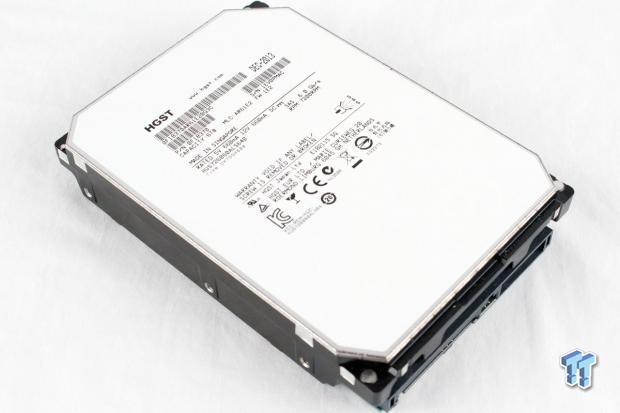
Datacenter HDD shipments have been growing at a 45 percent CAGR, roughly doubling the storage capacity of the datacenter every two years. Hyperscale datacenters are also under duress as their storage capacity is more than doubling every year. Unfortunately, areal density increases have slowed to 15 percent per year. Rapid density advancements have slowed to incremental increases as we reach PMR's limit. SMR has experienced limited success in a limited number of use-cases, and HAMR is still five years away from mass production by many estimates.
With no immediate jump in areal density on the horizon, HGST decided to take another path. The HGST Ultrastar He6 innovates by delivering 6TB of capacity through increased head and platter counts in the familiar 3.5-inch form factor. The 7,200 RPM He6 is available in SAS and SATA flavors and features a sustained speed of 177 MB/s and a 64MB cache buffer.
Today's leading HDDs have 5 platters and 10 heads. Simple math deduces that four more heads and two more platters can fit into the 3.5-inch form factor and provide an immediate capacity bump. Simplicity ends there, and air resistance becomes the biggest foe. Adding more platters and heads introduces wind turbulence that creates flutter, vibration, and drag. Extra drag necessitates stronger motors that require more power, and error rates skyrocket due to air buffeting the drive heads.
Helium is one-seventh the density of air and drastically reduces drag and turbulence. The helium concept emerged years ago, but the primary challenge was its penchant for escaping containment. HGST's proprietary HelioSeal technology traps helium and forgoes the use of fasteners, which reduces weight. This leads to a 38 percent lower weight-per-TB that is helpful for restricted floor loading environments. Sealing the drive makes the He6 impervious to outside air, removing restrictive humidity constraints in open-air datacenters. This also makes it well suited for cutting-edge immersion cooling.
Helium's lower wind resistance allows the use of thinner glass-substrate platters, enabling HGST's proprietary 7Stac design that packs 7 platters and 14 heads in the same 1-inch z-height. Less wind resistance also reduces drive motor power consumption. The He6 can significantly reduce cooling costs in large deployments because it runs 4-5 degrees cooler.
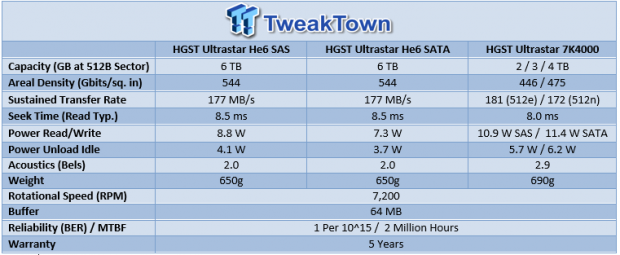
The He6 is the only 6TB HDD on the market, and for this evaluation, we compare the HGST Ultrastar He6 to the HGST Ultrastar 7K4000. The 7K4000 currently leads the 7,200 RPM segment in performance, efficiency, and reliability. The 7K4000 comes in 2TB, 3TB, and 4TB capacities, while the He6 is only available at 6TB. The He6 features a small jump in areal density, in tandem with more platters, to provide more capacity. The He6 is also much quieter and 50g lighter, but it takes a step back in performance. Seek time rises to 8.5 ms, and the He6 has a slightly lower sustained transfer rate.
Power consumption is drastically reduced in active and idle states, driving 23 percent lower idle power consumption and 49 percent better Watts-per-TB. Both drives feature a leading 2-million-hour MTBF, a five-year warranty, and the standard 1 per 10^15 BER rate.
The He6 was designed to provide the ultimate in storage density and power efficiency. Its innovative features can be a catalyst for denser storage infrastructure and loosened requirements for open-air datacenters. Let's take a closer look and compare its performance to the leading 7,200 RPM HDD.
HGST Ultrastar He6 Internals and Specifications
HGST Ultrastar He6 Internals


The HGST Ultrastar He6 comes in the typical 3.5-inch form factor. A distinguishing feature is the lack of components and fasteners on the top of the drive. There is a small round protrusion on the bottom left under the sticker; the rest of the surface of the drive is flat. The drive is noticeably lighter due to reduced components and the lack of fasteners.

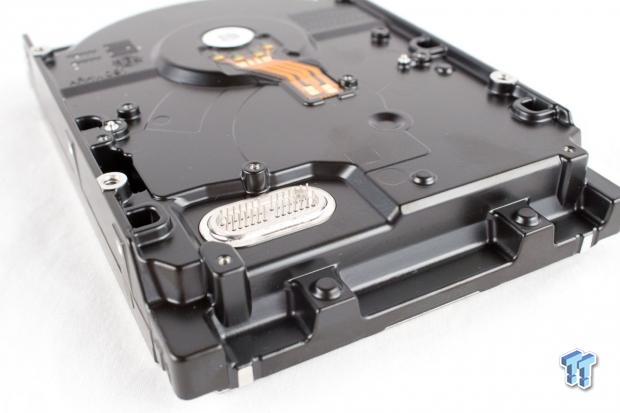
Upon removal of the PCB, we immediately note thick pins protruding from the bottom of the case. These pins mate with the PCB to provide communication with the drive. These pins are a departure from any other current HDD design. Most designs use flat pins that connect to the bottom of the PCB.


The plastic outcropping to the upper left of the PCB mates with the pins on the base of the drive. The NANYA 64-bit DRAM cache chip resides to the right, and the SMOOTH drive motor controller occupies the lower left of the PCB. There are accelerometers on the upper right and lower left, and the typical drive-motor power connections are in the middle of the lower edge of the PCB.
We peeled the sticker back to find the source of the protrusion. This sealed opening is where HGST injects helium during the last manufacturing steps. Each drive requires less helium than a typical child's balloon. If helium escapes, it will travel to the top of the room. Helium is harmless in low concentrations and is used instead of nitrogen for breathing during deep-sea diving.


The LSI TNNGG6282 controller powers the device. There is a thermal pad to transfer heat from the controller into the body of the drive, and a thick foam pad is placed between the drive housing and the PCB to reduce vibration. Limited sample availability forced us to refrain from pulling the drive apart for pictures of the new platter architecture. The graphic above does a nice job of highlighting the enhanced platter density.

We tested idle power and measured the He6 at 7watts and 5.3-5.4 watts during sleep intervals. The HGST 7K4000 has a much higher average idle power draw, but this is typical for the 7,200RPM segment.
HGST Ultrastar He6 Specifications
The HGST Ultrastar He6 utilizes Thermal Fly-height Control (TFC) to maintain performance in high-vibration environments and multi-drive deployments. The He6 is rated for 600,000 load/unload cycles and a yearly workload of 550TB. The drive features adaptive error correction and optional Bulk Data Encryption for SATA models and TCG Enterprise A for SAS models. The SAS model has a broader range of sector sizes and incrementally higher power consumption.
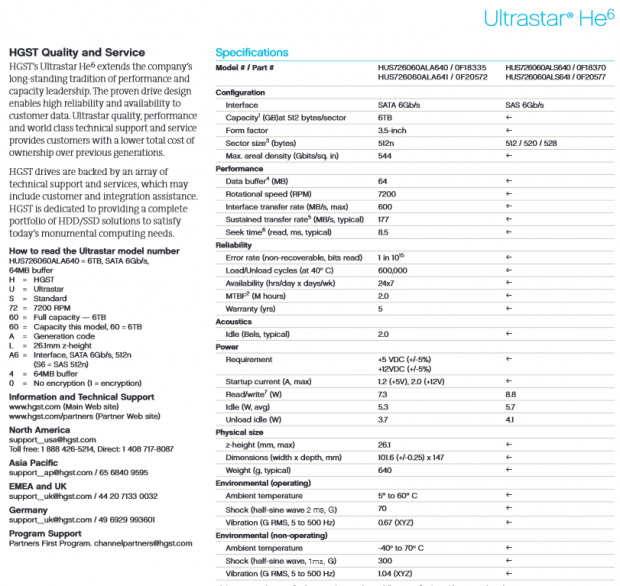
Test System and Methodology


Our approach to storage testing targets long-term performance with a high level of granularity. Many testing methods record peak and average measurements during the test period. These average values give a basic understanding of performance, but they fall short in providing the clearest view possible of I/O Quality of Service (QoS).
'Average' results do little to indicate performance variability experienced during actual deployment. The degree of variability is especially pertinent as many applications can hang or lag as they wait for I/O requests to complete. This testing methodology illustrates performance variability and includes average measurements during the measurement window.
While under load, all storage solutions deliver variable levels of performance. While this fluctuation is normal, the degree of variability is what separates enterprise storage solutions from typical client-side hardware. Providing ongoing measurements from our workloads with one-second reporting intervals illustrates product differentiation in relation to I/O QoS. Scatter charts give readers a basic understanding of I/O latency distribution without directly observing numerous graphs.
Consistent latency is the goal of every storage solution, and measurements such as Maximum Latency only illuminate the single longest I/O received during testing. This can be misleading as a single 'outlying I/O' can skew the view of an otherwise superb solution. Standard Deviation measurements consider latency distribution, but they do not always effectively illustrate I/O distribution with enough granularity to provide a clear picture of system performance. We utilize high-granularity I/O latency charts to illuminate performance during our test runs.
We measure power consumption during precondition runs. This provides measurements in time-based fashion, with results every second, to monitor power consumption behavior. We also present IOPS-to-Watts measurements to highlight efficiency.
We conduct our tests over the full LBA range to allow each HDD to highlight its average performance. Varying capacities should be taken into account when viewing results. Both test samples feature the SAS interface. It should be noted the SAS He6 consumes more power than the SATA variant. The first page of results will provide the 'key' to understanding and interpreting our test methodology.
Benchmarks - 4k Random Read/Write
4k Random Read/Write

Each level tested includes 300 data points (five minutes of one second reports) to illustrate performance variability. The line for each queue depth represents the average speed reported during the five-minute interval. 4k random speed measurements are an important metric when comparing drive performance as the hardest type of file access for any storage solution to master is small-file random. One of the most sought-after performance specifications, 4k random performance is a heavily marketed figure.
The HGST Ultrastar He6 averages 204 IOPS at QD256, while the 7K4000 delivers 215 IOPS.

Both drives deliver consistent performance and the best performance efficiency at QD64.

The He6 provides peak performance at QD128 with an average of 196 IOPS, and the 7K4000 peaks at QD64 with 206 IOPS.

The He6 and 7K4000 both provide optimal latency-to-IOPS performance at QD64.

Our write percentage testing illustrates the varying performance of each solution with mixed workloads. The 100 percent column to the right is a pure write workload of the 4k file size, and 0 percent represents a pure 4k read workload.
The He6 falls neatly below the speed of the 7K4000 and exhibits the same preference for read activity.

We record power consumption measurements during our test run at QD256. The He6 averages 7.22 watts, and the 7K4000 averages 8.67 watts during the measurement window. This falls in line with the expected power reduction advantages of the He6.


We generate IOPS-to-Watts measurements from data recorded during the test period. The He6 provides 34 IOPS-per-Watt in both workloads, and the 7K4000 measures 30 IOPS-per-Watt. The primary power advantage of the He6 is in Watts-per-TB measurements and idle power consumption. These performance-based efficiency enhancements are also an encouraging sign.
Benchmarks - 8k Random Read/Write
8k Random Read/Write

Server workloads rely heavily upon 8k performance, and we include this as a standard with each evaluation. Many of our server emulations also test 8k performance with various mixed read/write workloads.
The average 8k random read speed of the HGST Ultrastar He6 is 203 IOPS at QD256, and the 7K4000 takes a small lead with 215 IOPS at QD256.

Both drives deliver the best random activity performance-to-latency ratio at QD64.

The He6 offers up 194 IOPS at QD256 compared to the 206 IOPS from the 7K4000.


Both drives perform within a tight envelope as we mix in more write activity.

Power consumption for the He6 averages 8.49 watts, considerably lower than the 7K4000's 9.89 watt average.


Both drives fall into similar efficiency profiles for read and write activity, but the He6 scores a slight win.
Benchmarks - 128k Sequential Read/Write
128k Sequential Read/Write

We write to every LBA on both drives to highlight performance degradation from the outer to inner tracks of both drives. The drives begin with much higher speed on the outer tracks, 180 MB/s for the HGST Ultrastar He6 and 171 MB/s for the 7K4000. As we move to the inner tracks, the He6 falls to a low average of 86 MB/s, and the 7K4000 falls to 93 MB/s. The 7K4000 finishes its pass over its 4TB in 7.5 hours, and the He6 requires 11.5 hours to write the entire 6TB of data.

128k sequential speed reflects the maximum sequential throughput of the HDD. The He6 takes the lead in sequential read activity with an average of 179 MB/s. The 7K4000 lags behind with an average of 172 MB/s.

The He6 provides lower latency across the board with sequential read activity.

The He6 maintains its lead in sequential workloads with an average of 179 MB/s compared to 172 MB/s from the 7K4000.


The He6 also handles mixed workloads well as it continues to best the 7K4000 in sequential speed measurements.

The He6 averages 7.46 watts, much lower than the 8.72-watt average from the 7K4000.

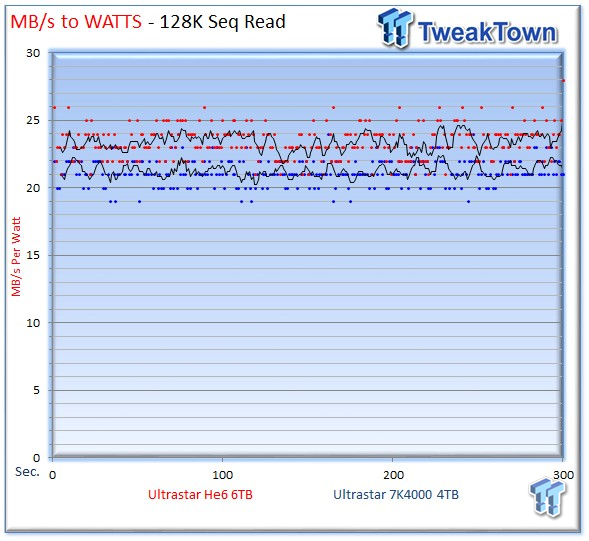
The He6 delivers a commanding lead in sequential workload efficiency.
Benchmarks - Database/OLTP and File Server
Database/OLTP

This test emulates Database and On-Line Transaction Processing (OLTP) workloads. OLTP is the processing of transactions such as credit cards and high frequency trading in the financial sector. Databases are the bread and butter of many enterprise deployments. These demanding 8k random workloads with a 66 percent read and 33 percent write distribution bring even the best solutions down to earth.
The He6 averages 210 IOPS at QD256, while the 7K4000 averages 224 IOPS.


The He6 averages 8.13 watts, and the 7K4000 requires 9.46 watts.

The 7K4000 closes the gap in efficiency testing with the OLTP workload. The He6 ekes out the win with an average of 25 IOPS-per-Watt compared to 23 IOPS-per-Watt from the 7K4000.
File Server

The file server profile represents typical file server workloads. This profile tests a wide variety of different file sizes simultaneously with an 80 percent read and 20 percent write distribution.
The 7K4000 continues to widen the performance gap in server workloads with its stellar average of 219 IOPS at QD256. The He6 delivers an average of 205 IOPS at QD256.


The He6 continues its lower power consumption with an average of 8.46 watts to the 7K4000's 9.95-watt average.

Both drives are closely matched with an average of 23.4 IOPS-per-Watt from the He6 and 20.9 IOPS-per-Watt from the 7K4000.
Benchmarks - Email Server
Email Server

The email server profile is a demanding 8k test with a 50 percent read and 50 percent write distribution. This application is indicative of the performance in heavy write workloads.
The HGST Ultrastar He6 averages 206 IOPS at QD256, while the 7K4000 averages 221 IOPS.


The He6 averages 8.05 watts, much lower than the 9.35 watts from the 7K4000.

The He6 manages to slightly best the 7K4000's efficiency in our final test.
Final Thoughts

The exponential growth of bulk and unstructured data is leading to innovative new storage techniques. Data is stored on different media based upon its importance, and cold data finds its way to the slowest mediums, such as tape, for long-term storage. Facebook is a great example of the challenges facing hyperscale datacenters. Facebook has a history of utilizing a number of innovative techniques to store data in a more cost effective manner, and the social media giant recently began storing cold data in petabyte Blu-ray storage racks. Facebook has even stated intentions to use very low quality NAND for cold data storage when the economics facilitate an inflection point. Unfortunately, that is not in the near future.
Tape and Blu-ray are great methods for the coldest of data, but solutions are needed that enable faster data retrieval for nearline storage applications. The HGST Ultrastar He6 serves the inexorable push for more efficiency by addressing the key obstacles of power consumption, cooling, and space. The price of powering storage devices exceeds initial acquisition costs, and cooling only exacerbates the issue. The He6 has markedly lower power consumption than any other 7,200 RPM HDD on the market and generates 4 degrees less heat.
Our power consumption tests were somewhat weighted against the He6. We tested the SAS version, which has a higher power draw than the SATA model. The He6 still exhibited much lower power consumption than the 7K4000 in all of our tests. The He6 featured an average of 1.4 watts less power consumption under load, and idle power draw measured 1.6 watts lower. This decrease in power consumption is fantastic for a device with 50 percent more storage. The power savings will add up quickly in large deployments with thousands of drives.
Floor space is at a premium in the datacenter, and each density increase saves an exponential amount of money. Containerized and modular datacenters require the utmost density. Storing more data in the same space also reduces the need for additional servers, HBAs, RAID controllers, and cabling. The He6 addresses this segment by providing more density and allowing the use of immersion cooling. Datacenters are relying more on open-air cooling, but they switch over to their own cooling when heat and humidity reach unusable levels. HelioSeal technology seals the case to keep helium in and humidity out.
We tested the He6 against its less spacious counterpart, the 4TB HGST Ultrastar 7K4000. The 7K4000 leads the pack of current HDDs in performance and efficiency, but there really isn't a suitable drive on the market for direct comparison. The He6 trailed the 7K4000 in random workload performance but remained competitive. The He6 led by a convincing margin in sequential workloads. In truth, the attraction of the He6 is not performance; it is efficiency.
The only barriers to adoption will stem from price, the unproven nature of helium drives, and the single source of supply. The new breed of OEMs are not hindered by old thinking and should adopt this technology quickly. Analysts from iSuppli, Gartner, and IDC are all predicting helium drives will be a key component in the datacenter for years to come. There will be an incremental price increase over typical drives, but TCO savings will offset this. The economics of the He6 are currently a bit muddy due to high prices typically encountered at the onset of availability.
The ability to cost-effectively mass produce helium HDDs is a big step forward, and HelioSeal and 7Stac technology will continue to mature. The helium design is complimentary to SMR and HAMR technologies, allowing for a future with even more storage density. It will be interesting to see if this approach is transferred over to low-capacity 10k and 15k drives.
The HGST Ultrastar He6 is an innovative solution that addresses the most pressing challenges in the datacenter. Its enhanced density and focus on superior efficiency garner the TweakTown Editor's Choice Award.
PRICING: You can find the HGST He6 (6TB) HDD for sale below. The prices listed are valid at the time of writing but can change at any time. Click the link to see the very latest pricing for the best deal.
United States: The HGST He6 (6TB) HDD retails for $739.99 at Amazon.

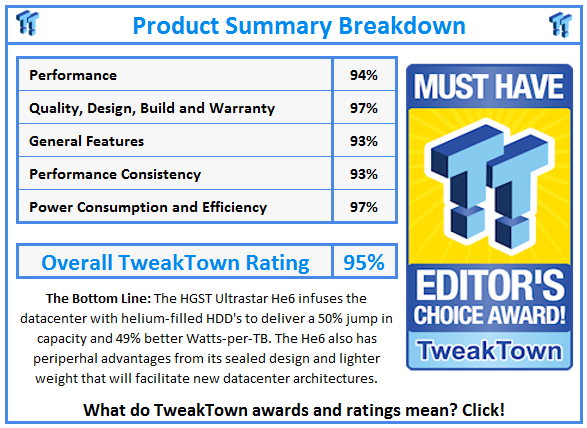
 United
States: Find other tech and computer products like this
over at
United
States: Find other tech and computer products like this
over at  United
Kingdom: Find other tech and computer products like this
over at
United
Kingdom: Find other tech and computer products like this
over at  Australia:
Find other tech and computer products like this over at
Australia:
Find other tech and computer products like this over at  Canada:
Find other tech and computer products like this over at
Canada:
Find other tech and computer products like this over at  Deutschland:
Finde andere Technik- und Computerprodukte wie dieses auf
Deutschland:
Finde andere Technik- und Computerprodukte wie dieses auf